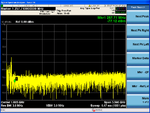aloishis89
Junior Member level 2
I am using a PSA4-5043+ amplifier in my design and am having trouble getting an output. I attached the relevant portion of my schematic. I am amplifying signals in the range of 500-600 MHz. If I probe the input to the amplifier, I can correctly see my signal, but the output appears to have a large DC component and low frequency harmonics. I attached a screenshot from my spectrum analyzer showing the probed output of the amplifier. I calculated the value of L21 by making it's reactance about 10 times bigger than my system's impedance (50 ohms). The lowest frequency I'll encounter is 470 MHz, so I did:
550j = j*2*pi(470*10^6)L
L = 186 nH
X_L = j*2*pi(100*10^6)(1.86*10^-7) = 117 ohms @ 100 MHz
I can't use the monolithic bias tee minicircuits makes because of budget constraints. Any help figuring this out would be greatly appreciated.
550j = j*2*pi(470*10^6)L
L = 186 nH
X_L = j*2*pi(100*10^6)(1.86*10^-7) = 117 ohms @ 100 MHz
I can't use the monolithic bias tee minicircuits makes because of budget constraints. Any help figuring this out would be greatly appreciated.

